Last updated on April 5th, 2023 at 12:37 pm
Ratio And Proportion Examples And Solutions For Bank PO, SSC CGL, SSC CHSL, Railway, Lic Exam Type-5
Dear readers, In ratio and proportion problem shortcut, tricks Type-1, Type-2, Type-3 and Type-4, I have already discussed a basic concept, shortcut tricks and some important frequently asked questions so before reading another type of ratio and proportion Examples shortcut tricks you should have to read ratio and proportion Type-1, Type-2, Type-3 and Type-4 .
Now, Today we are going to discuss ratio and proportion examples shortcut tricks type-5, 5.1, 5.2 and 5.3. In this type, we will discuss some important ratio and proportion Examples shortcut tricks and frequently asked questions based on Income Or Expenditure And Coins And Rupees. These questions will be very helpful for your upcoming all competitive exams like SSC, Bank PO, Railway, Lic etc.
Ratio And Proportion Examples Shortcut Tricks Type-5
(Q1) The ratio of the income to the expenditure of a family is 10:7. If the family’s expenses are Rs 10,500, then saving of the family is.
एक परिवार की आय और खर्च का अनुपात 10:7 है| यदि परिवार का खर्च Rs 10500 है तो परिवार की बचत ज्ञात करे|
Solution:

Saving = Income – Expenditure
= 10x – 7x = 3x
Given that,
⇒ 7x=10500
⇒ x=1500
∴ saving=3×1500=4500 Ans.
(Q2) The ratio of income and expenditure of a person is 11:10. If he saves Rs 9000 per annum, his monthly income is.
एक व्यक्ति की आय और खर्च का अनुपात 11:10 है| यदि वह RS 9000 हर वर्ष बचत करता है तो मासिक आय ज्ञात करें|
Solution:

Saving = 11x – 10x
= x
Given that,
x = 9000
Annual income=11x=11×9000
=Rs 99000
∴ Monthly income=99000/12=Rs 8250 Ans.
(Q3) The income of A, B and C are in the ratio 7:9:12 and their spendings are in the ratio 8:9:15. If A saves 1/4th of his income, then the saving os A, B and C are in the ratio of.
A, B और C की आय 7:9:12 के अनुपात में है तथा उनके खर्च 8:9:15 के अनुपात में है| यदि A अपनी आय का 1/4 भाग बचाता है, तो A, B और C की बचतों का अनुपात है|
Solution:

56 : 99 : 69 Ans.
[Rough:
According to question
7x-8y = (1/4)×7x
28x-32y=7x
21x=32y
x=32
y=21]
Ratio And Proportion Examples And Solutions For Bank PO, SSC CGL, SSC CHSL, Railway, Lic Exam Type-5.1
(Q1)The monthly income of two persons are in the ratio 2:3 and their monthly expenditure are in the ratio 5:9. if each of them saves Rs 600 per month, then their monthly incomes are.
दो व्यक्तियो की मासिक आय 2:3 के अनुपात में है तथा उनका मासिक व्यय 5:9 के अनुपात में है| यदि इनमें से प्रत्येक प्रतिमास Rs 600 की बचत करता है, तो उनकी मासिक आय है|
Solution:
Let the income of 1st and 2nd person are 2x and 3x
[Note: Income(I)=Expenditure(E) + Saving(S)]
∴ I – S = E
Now according to the question

⇒ 18x – 5400 = 15x – 3000
⇒ 3x = 2400
∴ x=800
Income of 1st person=2x=2×800
=Rs 1600 Ans.
Income of 2nd person=3x=3×800
=Rs 2400 Ans.
Second Method:
Step-1: सबसे पहले Income और Expenditure को cross-multiply करना है फिर उसके बाद difference निकालना है|
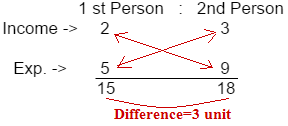
Step-2: Expenditure और Saving को cross-multiply करना है फिर उसके बाद difference निकालना है|

3 unit = 2400
1 unit = 800
Income of 1st person=2unit=Rs 1600 Ans.
Income of 2nd person=3unit=Rs 2400 Ans.
(Q2)The incomes of two persons are in the ratio 3:2 and their expenditure are in the ratio 5:3. If each saves Rs. 1000, then 1st person income is.
दो व्यक्तियो की मासिक आय 3:2 के अनुपात में है और उनका खर्च 5:3 के अनुपात में है| यदि प्रत्येक Rs 1000 बचाता है, तो पहले व्यक्ति की आय कितनी है|
Solution:
Let the income of 1st and 2nd person are 3x and 2x
[Note: Income(I)=Expenditure(E) + Saving(S)]
∴ I – S = E
Now according to the question

⇒ 9x – 3000 = 10x – 5000
⇒ x = 2000
Income of 1st person=3x=3×2000
=Rs 6000 Ans.
Second Method
Step-1: सबसे पहले Income और Expenditure को cross-multiply करना है फिर उसके बाद difference निकालना है|
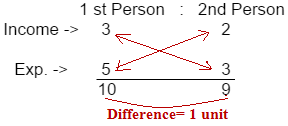
Step-2: Expenditure और Saving को cross-multiply करना है फिर उसके बाद difference निकालना है|

1 unit = 2000
Income of 1st person=3unit
=Rs 6000 Ans.
Ratio And Proportion Examples And Solutions For Bank PO, SSC CGL, SSC CHSL, Railway, Lic Exam Type-5.2
(Q1) The ratio of income of two persons is 5:3 and that of their expenditures is 9:5. Find the income of each person, if they save Rs 1300 and Rs 900 respectively.
दो व्यक्तियो की आय का अनुपात 5:3 है तथा उनके व्यय का अनुपात 9:5 है| यदि ये क्रमशः Rs 1300 और Rs 900 की बचत करते हैं, तो प्रत्येक की आय ज्ञात कीजिए|
Solution:
Let the income of 1st and 2nd person are 5x and 3x
Note: Income(I)=Expenditure(E) + Saving(S)
I – S = E
Now according to the question

⇒ 25x – 6500 = 27x – 8100
⇒ x= 800
Income of 1st person=5x=5×800
=Rs 4000 Ans.
Income of 2nd person=3x=3×800
=Rs 2400 Ans.
Second Method
Step-1: सबसे पहले Income और Expenditure को cross-multiply करना है फिर उसके बाद difference निकालना है
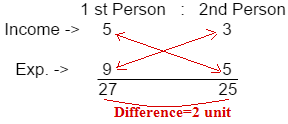
Step-2: Expenditure और Saving को cross-multiply करना है फिर उसके बाद difference निकालना है|

2 unit = 1600
1 unit = 800
Income of 1st person=5unit=Rs 4000 Ans.
Income of 2nd person=3unit=Rs 2400 Ans.
(Q2) Two person have their monthly incomes in the ratio 8:5, while their monthly expenditures are in the ratio 5:3. If they have saved Rs 12000 and Rs 10000 monthly respectively, then the difference in their monthly income is.
दो व्यक्तियो की मासिक आय 8:5 के अनुपात में है जबकि उनका मासिक व्यय 5:3 के अनुपात में है| यदि उन्होंने क्रमशः Rs 12000 और Rs 10,000 की मासिक बचत की हो, तो उनकी मासिक आय में अंतर कितना है|
Solution:
Let the income of 1st and 2nd person are 5x and 3x
[Note: Income(I)=Expenditure(E) + Saving(S)]
∴ I – S = E
Now according to the question

⇒ 24x-36000=25x-50000
⇒ x=14000
Income of 1st person=8x=8×14000
=Rs 112000
Income of 2nd person=5x=5×14000
=Rs 70000
Difference=112000-70000=42000 Ans.
OR
Difference in monthly income=8x-5x=3x
=3×14000=42000 Ans.
Second Method
Step-1: सबसे पहले Income और Expenditure को cross-multiply करना है फिर उसके बाद difference निकालना है
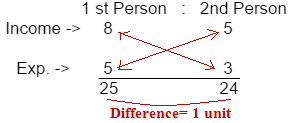
Step-2: Expenditure और Saving को cross-multiply करना है फिर उसके बाद difference निकालना है|

Difference in monthly income=8-5=3
Now,
1 unit=14000
3 unit=14000×3=42000 Ans.
Ratio And Proportion Examples And Solutions For Bank PO, SSC CGL, SSC CHSL, Railway, Lic Exam Type-5.3
(Q1) A box contains 280 coins of one-rupee, 50-paise and 25-paise. The values of each kind of the coins are in the ratio of 8:4:3. Then the number of 50-paise coins is.
एक बॉक्स में Rs 1, 50 पैसे और 25 पैसे के 280 सिक्के है| प्रत्येक प्रकार के सिक्के के मूल्य 8:4:3 के अनुपात में हैं, तो 50 पैसे के सिक्कों की संख्या बताइए|
Solution:
[Concept: 50 पैसे को Rs 1 बनाना है तो 50 पैसे को 2 से multiply करना होगा या यह भी कह सकते है 50 पैसे के 2 सिक्के लेंगे| इस प्रकार 50 पैसे के total 8 सिक्के होंगे(i.e 4×2=8)| 25 पैसे को Rs 1 बनाना है तो 25 पैसे को 4 से multiply करना होगा या यह भी कह सकते है 25 पैसे के 4 सिक्के लेंगे| इस प्रकार 25 पैसे के total 12 सिक्के होंगे(i.e 3×4=12)|]

Total no of coins=28
28 coins =280
1 coins = 10
No. of 50 paise coins = 8×10 =80 Ans.
(Q2) There are 480 coins in half rupees, quarter rupees and 10 paise coins and their values are proportional to 5:3:1. The number of coins in each case are.
50 पैसे, 25 पैसे और 10 पैसे के कुल 480 सिक्के है| उनका मूल्य 5:3:1 के अनुपात में है तो प्रत्येक सिक्कों की संख्या कितनी है|
Solution:
[Concept: 50 पैसे को Rs 1 बनाना है तो 50 पैसे को 2 से multiply करना होगा या यह भी कह सकते है 50 पैसे के 2 सिक्के लेंगे तो इस प्रकार 50 पैसे के total 10 सिक्के होंगे(i.e 5×2=10)| 25 पैसे को Rs 1 बनाना है तो 25 पैसे को 4 से multiply करना होगा या यह भी कह सकते है 25 पैसे के 4 सिक्के लेंगे तो इस प्रकार 25 पैसे के total 12 सिक्के होंगे(i.e 3×4=12)| 10 पैसे को Rs 1 बनाना है तो 10 पैसे को 10 से multiply करना होगा या यह भी कह सकते है 10 पैसे के 10 सिक्के लेंगे तो इस प्रकार 10 पैसे के total 10 सिक्के होंगे(i.e 1×10=10)|]

Total no of coins=32
32 coins =480
1 coins = 15
No. of 50 paise coins = 10×15 =150 Ans.
No. of 25 paise coins = 12×15 =180 Ans.
No. of 10 paise coins = 10×15 =150 Ans.
Ratio and Proportion Examples Shortcut Tricks for SSC CGL, Bank PO, SSC CHSL, Railway Exam Type-3 and Ratio and Proportion Examples Shortcut Tricks Type-4. In both types, I have already shared a Ratio and proportion Examples Shortcut Tricks, Basic concept and frequently asked a question if you have not read that yet, you should read it the right way here is the link.
Ratio and Proportion Problem type-4
If you have any queries regarding this topic feel free to ask me in the comments below.
Did you like this article? Share it with your friends on Facebook, Twitter, Whatsapp and Google plus!



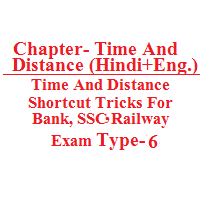



![[हिंदी] उच्च न्यायालय (High Court) MCQ Quiz – Objective Questions with Answer For SSC, UPPCS, IAS, CDS, BPSC, MPPCS Exam उच्च न्यायालय (High Court) MCQ Objective Questions Hindi](https://www.crackgovexam.com/wp-content/uploads/2023/10/उच्च-न्यायालय-High-Court-MCQ-Hindi-218x150.jpg)
![[हिंदी] सर्वोच्च न्यायालय/उच्चतम न्यायालय (Supreme Court) MCQ Objective Questions with Answer SSC Exam Hindi वर्ष 1999 से 2024 तक सर्वोच्च न्यायालय (Supreme Court) MCQ Objective Questions Hindi](https://www.crackgovexam.com/wp-content/uploads/2023/10/सर्वोच्च-न्यायालय-Supreme-Court-MCQ-Hindi-218x150.jpg)
![[हिंदी] मौलिक कर्त्तव्य (Fundamental Duties) MCQ Quiz – Objective Questions with Answer For SSC, UPPCS, IAS, CDS, BPSC, MPPCS Exam मौलिक कर्त्तव्य (Fundamental Duties) MCQ Objective Questions Hindi](https://www.crackgovexam.com/wp-content/uploads/2021/07/मौलिक-कर्त्तव्य-Fundamental-Duties-MCQ-Hindi-218x150.jpg)



















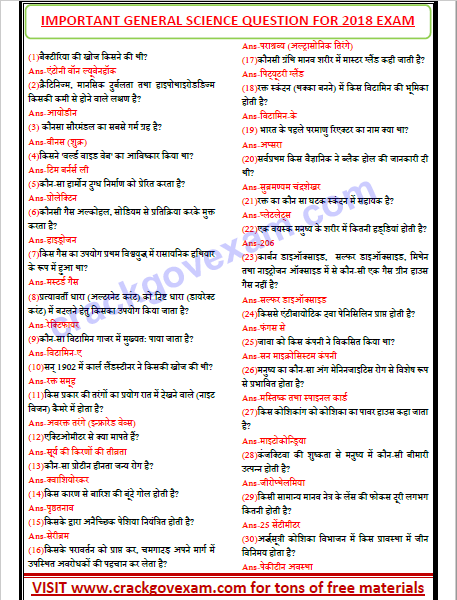
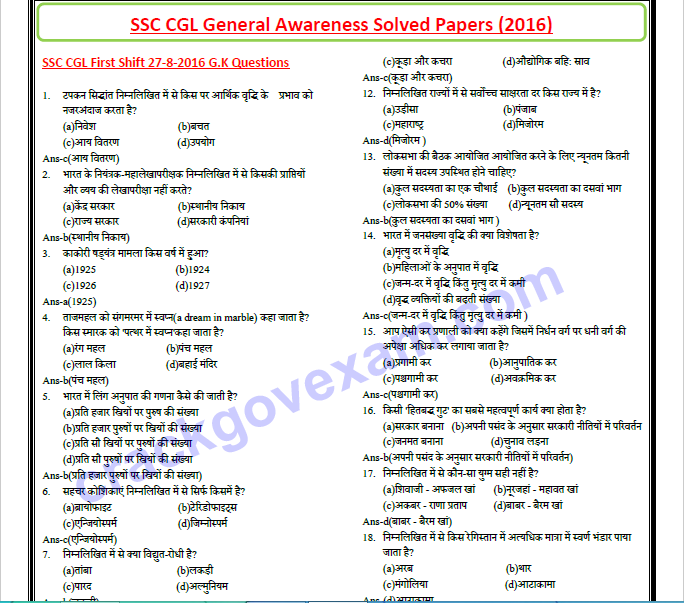









Nice method thank u
Bahut Achha method sir I like you method sir